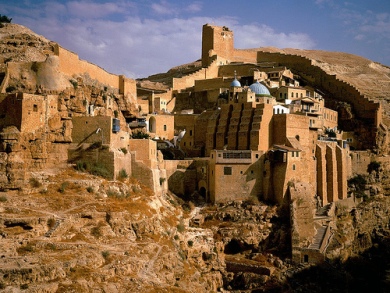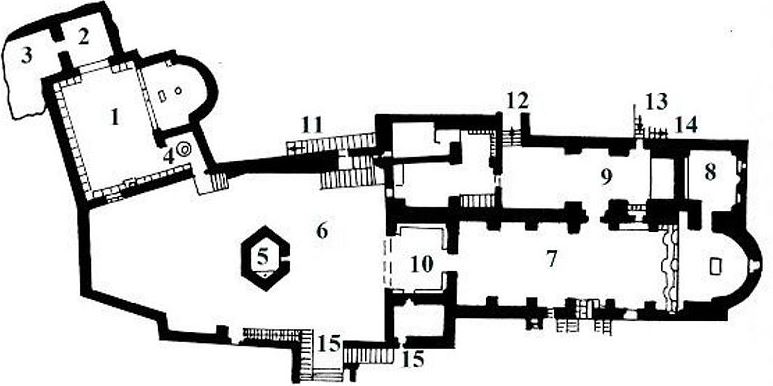

Location: 17 km (11 mi) East of Bethlehem Map
Tel. (02) 277 3135
Open 8am- 5pm daily
No women allowed!
Mar Saba Monastery, also known as the Holy Lavra of Saint Sabbas the Sanctified, is one of the oldest continuously inhabited Christian monasteries in the world, located in the Kidron Valley (Wadi en-Nar) approximately 15 kilometers southeast of Jerusalem and 12 kilometers east of Bethlehem in the West Bank, Palestinian Territories. Perched dramatically on the cliffs of the Judean Desert, this Greek Orthodox monastery, founded in 483 CE by Saint Sabbas (Saba) the Sanctified, is renowned for its austere beauty, historical significance, and enduring spiritual legacy.
Foundation and Early History (5th–7th Centuries)
Mar Saba was
established by Saint Sabbas, a Cappadocian monk born in 439 CE, who
sought a life of asceticism in the Judean Desert. After training under
Saint Euthymius and living as a hermit in a cave near the Kidron Valley,
Sabbas founded the monastery in 483 CE as a lavra—a semi-eremitic
community where monks lived in individual cells during the week and
gathered for communal worship on weekends. The site was chosen for its
isolation, ideal for contemplation, and its proximity to water sources
in the valley.
By the late 5th century, Mar Saba grew into a
major center of monastic life, attracting monks from across the
Byzantine Empire. Sabbas established strict rules emphasizing prayer,
manual labor, and asceticism, which shaped the monastery’s enduring
traditions. He also founded other monasteries, earning him the title
“the Sanctified” for his contributions to Palestinian monasticism. In
492 CE, Sabbas was appointed archimandrite (leader) of all lavra
monasteries in Palestine by the Patriarch of Jerusalem, cementing Mar
Saba’s prominence.
The monastery faced challenges during the
Persian invasion of 614 CE, when Sassanid forces killed 44 monks and
damaged the complex. The monks’ skulls are still preserved in the Chapel
of the Martyrs, a testament to this massacre. Despite this, Mar Saba
recovered, and by the 7th century, it thrived as a theological and
intellectual hub.
Islamic and Crusader Periods (7th–13th
Centuries)
Following the Muslim conquest of the Levant in the 7th
century, Mar Saba operated under Islamic rule, generally with tolerance,
as monks paid the jizya tax for protection. The monastery’s isolation
helped preserve its autonomy, though periodic raids by Bedouin tribes
posed threats. During this period, Mar Saba produced significant
theological works, including those of Saint John of Damascus (676–749
CE), a monk who defended Christian iconography during the Byzantine
Iconoclastic Controversy and wrote influential treatises on theology and
philosophy.
The Crusader period (1099–1291) brought renewed
attention to Mar Saba as a pilgrimage site. Crusaders restored parts of
the monastery, and Western pilgrims, including knights and nobles,
visited, leaving graffiti still visible today. However, the monastery
remained under Greek Orthodox control, resisting Latin influence.
Mamluk and Ottoman Periods (13th–19th Centuries)
Under Mamluk
(1250–1517) and Ottoman (1517–1917) rule, Mar Saba faced financial
strain and occasional raids, but its monks maintained their traditions.
The monastery’s library grew, preserving ancient manuscripts, and its
reputation as a spiritual stronghold attracted pilgrims from the
Orthodox world, particularly from Greece, Georgia, and Russia. In the
14th century, Serbian monks resided at Mar Saba, contributing to its
multicultural community.
The 19th century saw modernization
efforts, including the construction of a new guesthouse in 1840 and
repairs to the fortifications. Russian pilgrims, in particular, provided
financial support, strengthening ties with the Russian Orthodox Church.
Modern Era (20th–21st Centuries)
Mar Saba survived the turbulent
20th century, including British Mandate rule (1917–1948), the
Arab-Israeli conflicts, and the establishment of the West Bank under
Jordanian (1948–1967) and later Israeli control (1967–present). Its
location in Area C of the West Bank, under full Israeli administration,
has complicated access, requiring coordination with military
checkpoints.
In 2012, Mar Saba was added to UNESCO’s tentative
list of World Heritage Sites for its cultural and historical
significance. Today, it remains a functioning monastery, home to a small
community of Greek Orthodox monks, and a destination for pilgrims and
tourists, though access is restricted to men due to monastic rules.

1. Church of Saint Nicholas
2. Treasury
3. Ossuary
4. Baptistery
5. Chapel, resting place of Saint Sava
(Saba)
6. Courtyard with burial loculi
7. Cathedral of
the Annunciation
8. Treasury
9. North Chapel
10.
Narthex
11.Staircase to the upper entrance of the
monastery
12. Passageway to the North part of the
monastery
13. Staircase to the refectory
14. Staircase
to the lookout
15. Passageway to the South cells
Mar Saba’s architecture reflects its adaptation to the harsh desert
environment and its long history of expansion and repair. The monastery
clings to the steep cliffs of the Kidron Valley, with buildings
constructed from local limestone, blending seamlessly into the
landscape. Its fortified appearance, with high walls and towers, was
designed to protect against raids.
Key Features
Main Church
(Katholikon): Dedicated to Saint Sabbas, the central church features
Byzantine-style frescoes, icons, and a marble floor. It houses the tomb
of Saint Sabbas, a focal point for veneration. The church’s dome and
bell tower are iconic elements visible from a distance.
Chapel of the
Martyrs: A small chapel commemorates the monks killed in 614 CE,
displaying their skulls in a glass case as relics.
Monks’ Cells:
Scattered across the cliffs, many cells are built into natural caves,
reflecting the lavra’s original eremitic character. Modern cells within
the compound are simple, with minimal furnishings.
Library and
Scriptorium: The library contains over 3,000 ancient manuscripts,
including biblical texts, theological works, and hymns, some dating to
the 5th century. The scriptorium was a center for copying manuscripts,
particularly during the Byzantine and early Islamic periods.
Fortifications: The monastery’s walls, reinforced over centuries,
include watchtowers and a main gate. The “Women’s Tower” (Toupha), a
separate structure across the valley, was built in the 19th century to
house female pilgrims, as women are not permitted inside the main
complex.
Water Cisterns: Underground cisterns collect rainwater,
ensuring self-sufficiency in the arid environment.
Refectory and
Kitchen: The dining hall is modest, reflecting the monks’ ascetic
lifestyle, with meals prepared in a traditional kitchen using local
ingredients.
The monastery’s layout is irregular, shaped by the
terrain, with narrow stairways and passages connecting buildings. Its
aesthetic—rugged stone against the desert cliffs—evokes a sense of
timelessness and spiritual retreat.
Mar Saba is a cornerstone of Christian monasticism, particularly
within the Greek Orthodox tradition. Its significance stems from several
factors:
Spiritual Legacy
Saint Sabbas’ Rule: Sabbas’ monastic
rule, emphasizing solitude, communal worship, and manual labor,
influenced Orthodox monasticism worldwide. His Typikon (liturgical and
administrative guidelines) is still followed at Mar Saba and other
monasteries.
Theological Contributions: Monks like Saint John of
Damascus produced works that shaped Christian doctrine, particularly on
the veneration of icons and the nature of Christ. The monastery’s
scriptorium preserved Greek, Aramaic, and Arabic texts, bridging
Byzantine and Islamic intellectual traditions.
Pilgrimage
Destination: Mar Saba attracts Orthodox pilgrims, especially during the
feast of Saint Sabbas (December 5), when liturgies draw monks and
visitors from Jerusalem and beyond.
Cultural Impact
Multicultural History: Mar Saba hosted monks from diverse regions,
including Cappadocia, Syria, Georgia, Serbia, and Russia, fostering
cultural exchange. Its manuscripts reflect this diversity, with texts in
multiple languages.
Art and Iconography: The monastery’s frescoes and
icons, though faded, are examples of Byzantine art, depicting saints,
biblical scenes, and geometric patterns. The iconostasis in the main
church is particularly revered.
Preservation of Tradition: Mar Saba’s
adherence to ancient practices, such as the Julian calendar and
all-night vigils, makes it a living museum of early Christian
monasticism.
Daily Life at Mar Saba
The monastery is home to
approximately 10–15 monks, a significant decline from its peak of over
150 in the Byzantine era. The monks, primarily Greek and Palestinian,
follow a rigorous schedule rooted in prayer and labor:
Prayer:
The day begins with the Midnight Office (around 2:00 AM), followed by
Matins, the Divine Liturgy, and other services, totaling up to 8 hours
of prayer daily. Services are conducted in Greek, with some Arabic
elements.
Manual Labor: Monks maintain the monastery, tend a small
garden, produce candles and incense, and preserve manuscripts. Some
engage in icon painting or hospitality for visitors.
Ascetic
Practices: Meals are simple, typically consisting of bread, olives,
vegetables, and occasional fish, with fasting observed on most days.
Monks live in sparse cells, emphasizing detachment from material
comforts.
Hospitality: Male pilgrims and visitors are welcomed, often
offered tea or coffee, but must adhere to strict rules, including
silence during services and modest attire.
The monks’ isolation
fosters contemplation, though they maintain contact with the
Patriarchate of Jerusalem and occasionally travel for religious duties.
Access and Restrictions
Gender Restriction: Women are not
permitted inside Mar Saba, a rule rooted in its all-male monastic
tradition. Female visitors can view the monastery from the Women’s Tower
or nearby viewpoints.
Location: Situated in Area C of the West Bank,
access requires passing Israeli military checkpoints. Visitors need
passports and must coordinate with the monastery, as it is not always
open to tourists.
Transportation: From Jerusalem or Bethlehem, taxis
or private vehicles are the primary means of reaching Mar Saba, as
public transport is limited. The road is paved but winding, with
stunning desert views.
Preservation
Conservation Efforts: The
monastery faces challenges from natural erosion, humidity affecting
manuscripts, and limited funding for restoration. International
organizations, including UNESCO, have supported preservation efforts,
particularly for the library.
Tourism: While tourism boosts
awareness, it strains the monks’ resources and disrupts their solitude.
Guided tours, often arranged through Jerusalem or Bethlehem agencies,
are recommended to respect monastic life.
Geopolitical Context
Mar Saba’s location in the West Bank places it in a politically
sensitive area. The monastery maintains neutrality, focusing on its
spiritual mission, but regional tensions can affect visitor numbers and
access.
For those planning a visit:
Hours: The monastery is typically open
to male visitors from 9:00 AM to 3:00 PM, though hours vary. It is
closed during major Orthodox feasts and Lent.
Dress Code: Modest
clothing (long sleeves, pants) is required, and photography inside the
church is prohibited.
Highlights: Key sites include the main church,
the Chapel of the Martyrs, and the cliffside views. The library is not
open to the public but may be discussed by guides.
Tips: Bring water,
sunscreen, and sturdy shoes, as the terrain is rugged. Respect the
monks’ silence and avoid loud behavior.
Excavations around Mar Saba, particularly in the 20th century, uncovered Byzantine-era artifacts, including pottery, coins, and mosaic fragments, confirming its early history. The monastery’s library remains a treasure trove, with ongoing efforts to digitize manuscripts for global access. In 2015, a rare 6th-century manuscript of the Gospel of Mark was identified, highlighting Mar Saba’s role in preserving early Christian texts.